Related Research Articles

The City of David, known locally mostly as Wadi Hilweh, is the name given to an archaeological site considered by most scholars to be the original settlement core of Jerusalem during the Bronze and Iron Ages. It is situated on southern part of the eastern ridge of ancient Jerusalem, west of the Kidron Valley and east of the Tyropoeon Valley, to the immediate south of the Temple Mount.

Beit She'an, also Beth-shean, formerly Beisan, is a town in the Northern District of Israel. The town lies at the Beit She'an Valley about 120 m below sea level.

Tel Megiddo is the site of the ancient city of Megiddo, the remains of which form a tell or archaeological mound, situated in northern Israel at the western edge of the Jezreel Valley about 30 kilometres (19 mi) southeast of Haifa near the depopulated Palestinian town of Lajjun and subsequently Kibbutz Megiddo. Megiddo is known for its historical, geographical, and theological importance, especially under its Greek name Armageddon. During the Bronze Age, Megiddo was an important Canaanite city-state. During the Iron Age, it was a royal city in the Kingdom of Israel.

The archaeology of Israel is the study of the archaeology of the present-day Israel, stretching from prehistory through three millennia of documented history. The ancient Land of Israel was a geographical bridge between the political and cultural centers of Mesopotamia and Egypt.

Israel Finkelstein is an Israeli archaeologist, professor emeritus at Tel Aviv University and the head of the School of Archaeology and Maritime Cultures at the University of Haifa. Finkelstein is active in the archaeology of the Levant and is an applicant of archaeological data in reconstructing biblical history. Finkelstein is the current excavator of Megiddo, a key site for the study of the Bronze and Iron Ages in the Levant.

Tel Arad or Tell 'Arad is an archaeological tell, or mound, located west of the Dead Sea, about 10 kilometres west of the modern Israeli city of Arad in an area surrounded by mountain ridges which is known as the Arad Plain. The site is about 10.1 ha.

Gath or Gat was one of the five cities of the Philistine pentapolis during the Iron Age. It was located in northeastern Philistia, close to the border with Judah. Gath is often mentioned in the Hebrew Bible and its existence is confirmed by Egyptian inscriptions. Already of significance during the Bronze Age, the city is believed to be mentioned in the El-Amarna letters as Gimti/Gintu, ruled by the two Shuwardata and 'Abdi-Ashtarti. Another Gath, known as Ginti-kirmil also appears in the Amarna letters.
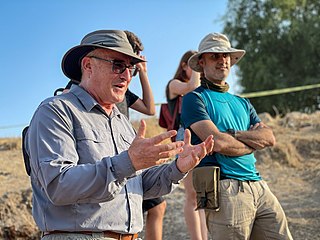
Aren Maeir is an American-born Israeli archaeologist and professor in the Department of Land of Israel Studies and Archaeology at Bar-Ilan University. He is director of the Tell es-Safi/Gath Archaeological Project.
Khirbet Kerak or Beth Yerah is a tell located on the southern shore of the Sea of Galilee in modern-day Israel. The tell spans an area of over 50 acres—one of the largest in the Levant—and contains remains dating from the Early Bronze Age and from the Persian period through to the Early Islamic period.
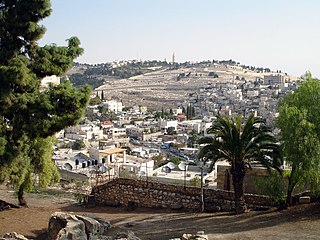
Ophel is the biblical term given to a certain part of a settlement or city that is elevated from its surroundings, and probably means fortified hill or risen area. In the Hebrew Bible, the term is used about two cities: Jerusalem, as in 2 Chronicles 27:3 and 33:14 and Nehemiah 3:26 and 11:21, and Samaria, mentioned in 2 Kings 5:24. The Mesha Stele, written in Moabite, a Canaanite language closely related to Biblical Hebrew, is the only extra-biblical source using the word, also in connection to a fortified place.

The Yarmukian culture was a Pottery Neolithic A (PNA) culture of the ancient Levant. It was the first culture in prehistoric Syria and one of the oldest in the Levant to make use of pottery. The Yarmukian derives its name from the Yarmuk River, which flows near its type site of Sha'ar Hagolan at the foot of the Golan Heights. This culture existed alongside the Lodian, or Jericho IX culture and the Nizzanim culture to the south.
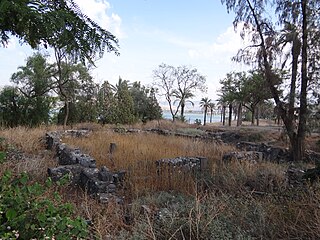
Al-Sinnabra or Sinn en-Nabra, is the Arabic place name for a historic site on the southern shore of the Sea of Galilee in modern-day Israel. The ancient site lay on a spur from the hills that close the southern end of the Sea of Galilee, next to which towards its south being the tell, Khirbet Kerak or Bet Yerah, one of the largest in the Levant, spanning an area of over 50 acres. Bet Yerah was the Hellenistic era twin city of Sennabris, as al-Sinnabra was known in Classical antiquity, and its remains are located at the same tell.
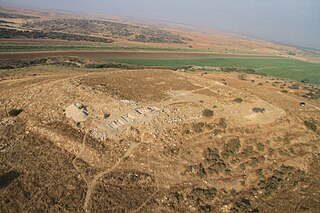
Tel Burna is an archaeological site located in the Shephelah, along the banks of Nahal Guvrin, not far from modern-day Qiryat Gat. Tel Burna is located near Beit Guvrin/Maresha, Tel Goded, Lachish, Tell es-Safi/Gath and Tel Zayit. The site is thought to have been one of a series of sites along the border between Judah and Philistia.

The Givati Parking Lot dig is an archaeological excavation located in Silwan in advance of building project commissioned by the El'ad Association. It is adjacent to the City of David archaeological site. The dig was conducted by Doron Ben-Ami and Yana Tchekhanovets of the Israel Antiquities Authority and underwritten by the City of David Foundation. While the IAA conducts the excavations, the project and site is managed by El'ad.
Avi Gopher is an Israeli archaeologist. He is a professor at the University of Tel Aviv.

'En Esur, also En Esur or Ein Asawir, is an ancient site located on the northern Sharon Plain, at the entrance of the Wadi Ara pass leading from the Coastal Plain further inland. The site includes an archaeological mound (tell), called Tel Esur or Tell el-Asawir, another unnamed mound, and two springs, one of which gives the site its name.

Tel Yarmuth or Khirbet Yarmuk is an ancient Near East archaeological site in Israel located 25 kilometers southwest of Jerusalem and near modern Beit Shemesh. It is a large primarily single-period site and has been suggested as possibly being the city of Jarmuth, being only a tentative identification, as it is based solely on the similarity of the Hebrew name with the Arabic name and its areal location.
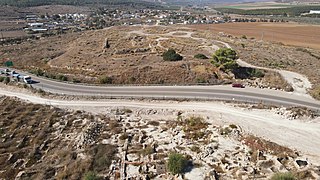
Tel Beit Shemesh is a small archaeological tell northeast of the modern city of Beit Shemesh.
The Sonia and Marco Nadler Institute of Archaeology, known also as Tel Aviv University Institute of Archaeology, is a research facility at the Lester and Sally Entin Faculty of Humanities. Founded in 1968 by Yohanan Aharoni, the institute sponsors interdisciplinary and international fieldwork and research projects on ancient human societies of the Ancient Near East and the Mediterranean Sea. Fieldwork includes archaeological excavation and survey in key sites scattered all over Israel from prehistoric, biblical and classical periods. It is currently headed by Yuval Gadot.
References
- ↑ "Prof. Raphael Greenberg". Tel Aviv University. Retrieved 2021-11-17.
- ↑ Watzman, Haim (May 1, 2007). "Deep divisions". Nature. 447 (7140): 22–24. doi: 10.1038/447022a . PMID 17476239.
- ↑ Friedman, Matti (2008). "Politics, archaeology collide beneath Jerusalem". USA Today.
- ↑ http://www.sciencemag.org/cgi/content/full/sci;315/5812/588 [ dead link ]
- ↑ "From Shiloah to Silwan - An Alternative Archaeological Tour of Ancient Jerusalem". Archived from the original on March 14, 2008.
- ↑ Green, Michael (2 March 2008). "Digging too deep?". The Jerusalem Post. Retrieved 2021-11-17.